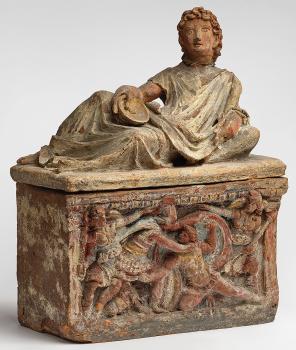American Journal of Archaeology | The Journal of the Archaeological Institute of America
You are here
Tracking Color Through Time: Polychromy on Etruscan Urns from Ancient Creation to Modern Intervention
April 2024 (128.2)
Tracking Color Through Time: Polychromy on Etruscan Urns from Ancient Creation to Modern Intervention
A comparative study of four Etruscan terracotta urns from Chiusi, Italy, investigates their ancient polychromy and the urns’ trajectories through changing modern-day art market practices and museum conservation policies. The objects’ shared moldmade motif of a specific scene from Sophocles’ play Antigone makes this group particularly suitable for illustrating differences and similarities in their past and present materiality, uncovered by multispectral imaging and chemical analyses. The analysis of the urns revealed some recurring patterns but also variations in the color scheme of the repeated scene. Moreover, the study underlines how scientific analysis of the polychromy is potentially a useful tool to assess the originality of archaeological artifacts, even in cases of excessive cleaning. The detection of the modern pigment Prussian blue hints at a now-lost chapter of modern overpaint and its later removal on one of the examined urns. This is used as point of departure for a discussion of the changing attitudes and approaches to restoration and conservation in archaeology and art history and their sometimes radical effects on the present-day appearance of museum artifacts.
Tracking Color Through Time: Polychromy on Etruscan Urns from Ancient Creation to Modern Intervention
By Cecilie Brøns, Jens Stenger, Anna Katerinopoulou, Katherine Eremin, Kate Smith, Georgina Rayner, Susanne Ebbinghaus, and Jacob Kveiborg
American Journal of Archaeology Vol. 128, No. 2 (April 2024), pp. 167-197
DOI: 10.1086/728694
© 2024 Archaeological Institute of America


